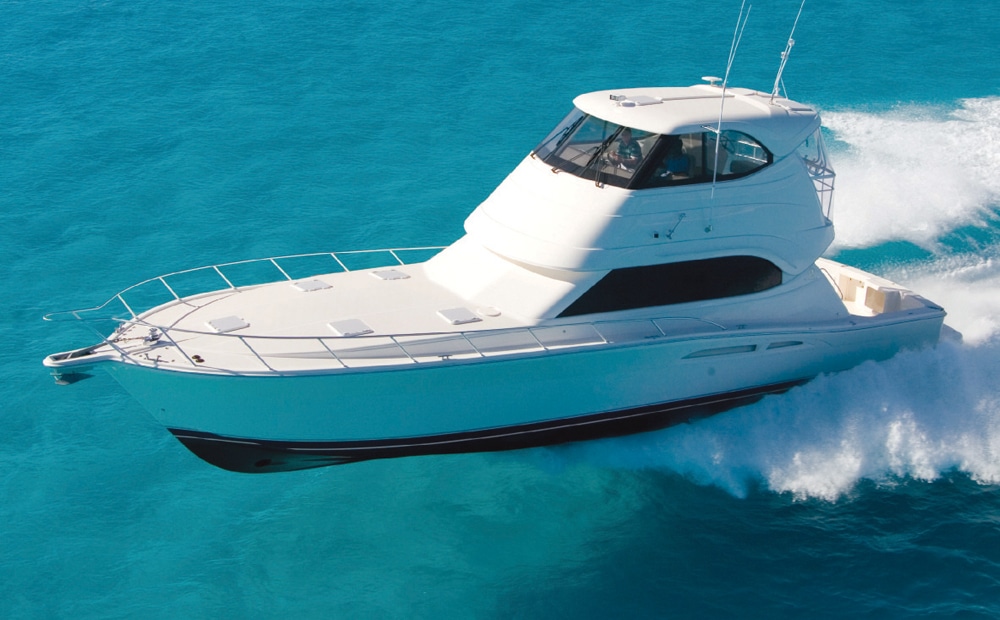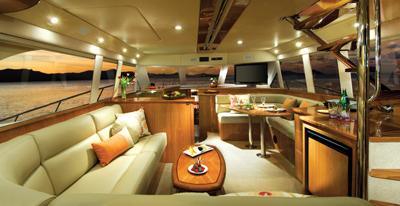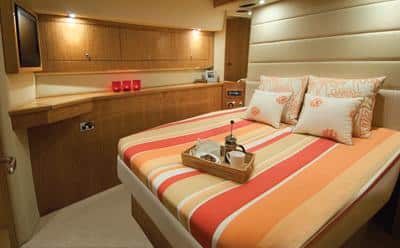
Riviera 51 Series II
Not that long ago, serious anglers snarled at even the idea of a pod-powered sportfish. When Volvo introduced the IPS systems in 2004, they were primarily being installed on comfort-focused expressstyle cruisers. But the times they are a-changin’.
An early adopter in the sportfish market was Spencer, with the Volvo IPS powered Spencer 43 Express. The most immediate and obvious benefit was seen in the expanded accommodations on this style of boat, created by placing the engines aft, under the cockpit. However, another tangible plus was the efficiency and exhaustfree operation afforded by the IPS drives. As the system becomes more readily accepted by diehard anglers, many more production builders are now embracing Volvo IPS (and Zeus-powered boats) for use in their convertible designs.
Australia’s Riviera is a prime example of a builder that took a good boat, and expanded its appeal by offering an IPS power option. One hundred and fifty eight conventional-shaft-drive 51s have been built since the model was first introduced in 2002, and the IPS option is pumping new life into the convertible since its introduction in late 2008. Riviera’s Stephen Milne explained to me that that the company isn’t looking to design a convertible that occasionally cruises, but instead is concentrating on creating a cruising boat that occasionally fishes. In doing so, they have succeeded in producing a boat that will be able to serve several masters.
While testing a fully loaded 51 off Grahams Point, south of Sydney, I was impressed with the smooth running characteristics. Pushing the electronic controls all the way forward resulted in an effortless rise out of the hole with no protest from the three, six-cylinder, 435-horsepower IPS 600s resting snugly under the cockpit. We achieved a top speed of 29.9 knots and then backed off to 3000 rpm, settling in with a cruising speed of 23 knots, while burning a total of 48 gallons per hour. At this speed, we measured a whisper-like sound reading of 68 decibels (the normal level of conversation is 64). The 51 was a blast to drive, and greeted the building head sea coming into the inlet with ease, settling gradually back into the trough. The IPS drives deliver a rapid response at the helm—she lost only a knot and a half when turned hard over, spinning in less than a boat length.
I’ve operated more than a dozen IPS-powered boats with the joystick control and find the response very intuitive. The throttle response is also smooth and natural. This particular 51’s owner was a firsttime buyer and was reportedly attracted to the ease of maneuverability afforded by IPS.
The line of sight from the centerline helm on the semi-enclosed bridge was good. All the breakers are easily accessible, although I would like to see the engine gauges placed lower in the line of sight, instead of above the helmsman on the overhead console. There is more than enough space on the large, three-panel electronics display. (For anglers and backing down, there is a third station in the cockpit.) Our test boat featured a wet bar to port with a refrigerator and sink. A large U-shaped settee with a table is to port, making a great spot to have a morning cup of coffee. By opening the aft Isinglass drop curtains, the side windows, and overhead hatch, the 51’s bridge morphs into an open layout. A standard bridge is also available, which places the helm farther aft. The entire space on our test boat was air-conditioned.

A staircase to the saloon provides access to the lower deck. As is customary on sportfish models outside of North America, the 51 has a three-panel, forward facing windshield. This can be ordered as a solid front, allowing for additional lockers. Beneath the saloon is a huge space where the engines used to be. The fuel tank remains on the centerline and abaft the tank is an open stowage area. On our test boat it held deck chairs, food, cases of wine and beer, and various water toys. With a little creativity, the space could turn into an incredible tackle locker, with rod stowage. The space also hides the generator, pumps, and air conditioning, creating an easy service environment. Riviera offers an option to fit this out as crew stateroom and head as well. (Pass!)
The after portion of the cockpit lifts to access the triple IPS 600s. Surprisingly, there is ample space on all sides of the engines for routine service. If you’re in a sloppy seaway with boarding seas and need to service the engine, you can gain access to the service area from the saloon. I would hesitate to open the large hatch in nasty conditions.
The cockpit features a lighted livewell, tackle prep station, fishboxes, and additional stowage along the sides of the cockpit. There is a backing plate ready to accept the installation of a fighting chair.
The side decks are wide, taking some of the gymnastics out of the passage to the foredeck necessary on other convertible designs, and our test boat was equipped with side rails down three-quarters of the side.

The fit and finish of the interior is well executed and extra attention is given to utilizing every available inch. This boat could easily head off to tournaments in Mexico or the Bahamas, filled with everything a demanding crew needs. The master stateroom is to starboard and thanks to the large hatches, the space doesn’t feel as cave-like as some similar convertible designs. Another double is forward, and a second guest stateroom with twin bunks lines the port passageway.
As more than a few builders have, Riviera has taken a few bruises in the recent economic downturn. Yet, after my two factory visits in the last 12 months, it’s obvious to me that the company is once again investing in new products, and looking forward.
The Riviera Group, (772) 872-7260; www.riviera.com.au









